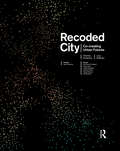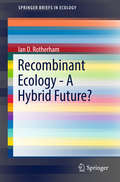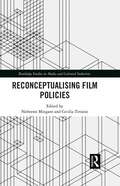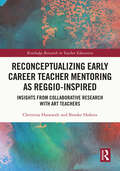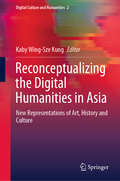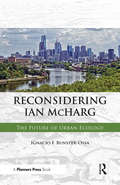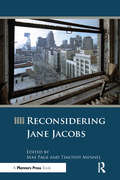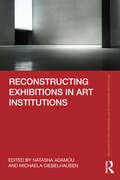- Table View
- List View
Reclining Figure by Henry Moore (Large Print)
by Rnib BookshareThis is an image of a marble sculpture of a standing man with his head at the top of the page and his feet at the bottom of the page. There is a locator dot shown, which will be at the top left when the image is the right way up. The man is facing forward. The head is upright and facing slightly to the right so one blank eye can be found but the other is largely hidden by the nose. He has medium length curly hair. He is naked with a sculpted cloth over his shoulder held by his bent arm on the right. The arm to the left hangs down straight. The body is slim and slightly muscular. The statue is in a classic pose with the body's weight on the leg to the left and the right leg relaxed to the right. The hips are level, the waist is slightly to the right and the shoulders tilted to the left. The statue stands on a low plinth. There is a small stump of wood behind his leg on the left in the bottom centre of the page.
Reclining Figure by Henry Moore (UEB contracted)
by Rnib BookshareThis is an image of a sculpture of a reclining woman. There is a locator dot shown, which will be at the top left when the image is the right way up. The sculpture is shown from the side with the head to the top right, and where the feet would be to the bottom left. It is an abstract sculpture. The upper part of the head has a downward curving recess. Down and slightly right from it is the sculptures left shoulder and upper arm. The figure rests on her elbows so the lower arm goes to the left from the bent elbow. The other arm is similarly bent but only parts of this lower arm can be found as it is partially hidden by part of the body. From the elbow it goes left, disappears behind the body then reappears briefly where there is a hole in the body and it shows through. The rest of the body is to the left. The knees are bent up and the lower legs go down to the bottom left of the image. The sculpture does not have feet.
Reclining Figure by Henry Moore (UEB contracted)
by Rnib BookshareThis is an image of a marble sculpture of a standing man with his head at the top of the page and his feet at the bottom of the page. There is a locator dot shown, which will be at the top left when the image is the right way up. The man is facing forward. The head is upright and facing slightly to the right so one blank eye can be found but the other is largely hidden by the nose. He has medium length curly hair. He is naked with a sculpted cloth over his shoulder held by his bent arm on the right. The arm to the left hangs down straight. The body is slim and slightly muscular. The statue is in a classic pose with the body's weight on the leg to the left and the right leg relaxed to the right. The hips are level, the waist is slightly to the right and the shoulders tilted to the left. The statue stands on a low plinth. There is a small stump of wood behind his leg on the left in the bottom centre of the page.
Reclining Figure by Henry Moore (UEB uncontracted)
by Rnib BookshareThis is an image of a sculpture of a reclining woman. There is a locator dot shown, which will be at the top left when the image is the right way up. The sculpture is shown from the side with the head to the top right, and where the feet would be to the bottom left. It is an abstract sculpture. The upper part of the head has a downward curving recess. Down and slightly right from it is the sculptures left shoulder and upper arm. The figure rests on her elbows so the lower arm goes to the left from the bent elbow. The other arm is similarly bent but only parts of this lower arm can be found as it is partially hidden by part of the body. From the elbow it goes left, disappears behind the body then reappears briefly where there is a hole in the body and it shows through. The rest of the body is to the left. The knees are bent up and the lower legs go down to the bottom left of the image. The sculpture does not have feet.
Reclining Figure by Henry Moore (UEB uncontracted)
by Rnib BookshareThis is an image of a marble sculpture of a standing man with his head at the top of the page and his feet at the bottom of the page. There is a locator dot shown, which will be at the top left when the image is the right way up. The man is facing forward. The head is upright and facing slightly to the right so one blank eye can be found but the other is largely hidden by the nose. He has medium length curly hair. He is naked with a sculpted cloth over his shoulder held by his bent arm on the right. The arm to the left hangs down straight. The body is slim and slightly muscular. The statue is in a classic pose with the body's weight on the leg to the left and the right leg relaxed to the right. The hips are level, the waist is slightly to the right and the shoulders tilted to the left. The statue stands on a low plinth. There is a small stump of wood behind his leg on the left in the bottom centre of the page.
The Reclining Nude: Agnès Varda, Catherine Breillat, and Nan Goldin (Contemporary French and Francophone Cultures #65)
by Emma WilsonThe figure of a woman reclining, in repose, displayed, abandoned, fallen, asleep, or dreaming, returns in the work of women filmmakers and photographers in the twentieth and twenty-first centuries. Filmmakers Agnès Varda and Catherine Breillat, and American photographer working in Paris, Nan Goldin, return to the paintings of Titian, Velázquez, Goya, Courbet, and others, re-imagining, and re-purposing, their images of female beauty, display, (auto)eroticism, and intimacy. This book, a sensuous evocation of these feminist works, claims a female-identified pleasure in looking. The artists explored align images of repose and sensuality with other images of horizontality and proneness, of strong emotional content, images of erotic involvement, of vulnerability, of bodily contortion, of listlessness, grief, and depression. The reclining nude is for all three artists a starting point for a reflection on the relation of film, projections, and still photography, to painting, and a sustained re-imagining of the meanings conjured through serial returns to a particular pose. This book claims that the image of the reclining nude is compelling, for female-identified artists – and for all allied in feeling and picturing femininity – in the sensitive, ethically adventurous, politically complex feminist issues it engages. The reclining nude is an image of passivity, of submission, of hedonism. It allows thought about passivity as pleasure, about depression and grief figured posturally, about indolence as a form of resistance and anarchy. Through this image, female-identified artists have claimed freedom to offer new focus on these extremes of emotion. They are re-imagining horizontality.
Recoded City: Co-Creating Urban Futures
by Thomas Ermacora Lucy BullivantRecoded City examines alternative urban design, planning and architecture for the other 90%: namely the practice of participatory placemaking, a burgeoning practice that co-author Thomas Ermacora terms ‘recoding’. In combining bottom-up and top-down means of regenerating and rebalancing neighbourhoods affected by declining welfare or struck by disaster, this growing movement brings greater resilience. Recoded City sheds light on a new epoch in the relationship between cities and civil society by presenting an emerging range of collaborative solutions and distributed governance models. The authors draw on their own fresh research of global pioneers forging localist design strategies, public-realm interventions and new stakeholder dynamics. As the world becomes increasingly digital and virtual, a myriad of online tools and technological options is becoming available. These give unprecedented co-creation opportunities to communities and professionals alike, yielding the benefits of a more open – DIY – society. Because of its close engagement with people, place and local identity, the field of participatory placemaking has huge untapped potential. Responding to the challenges of the Anthropocene era, Recoded City is for decision-makers, developers and practitioners working globally to make better and more liveable cities.
Recoded City: Co-Creating Urban Futures
by Thomas Ermacora Lucy BullivantRecoded City examines alternative urban design, planning and architecture for the other 90%: namely the practice of participatory placemaking, a burgeoning practice that co-author Thomas Ermacora terms ‘recoding’. In combining bottom-up and top-down means of regenerating and rebalancing neighbourhoods affected by declining welfare or struck by disaster, this growing movement brings greater resilience. Recoded City sheds light on a new epoch in the relationship between cities and civil society by presenting an emerging range of collaborative solutions and distributed governance models. The authors draw on their own fresh research of global pioneers forging localist design strategies, public-realm interventions and new stakeholder dynamics. As the world becomes increasingly digital and virtual, a myriad of online tools and technological options is becoming available. These give unprecedented co-creation opportunities to communities and professionals alike, yielding the benefits of a more open – DIY – society. Because of its close engagement with people, place and local identity, the field of participatory placemaking has huge untapped potential. Responding to the challenges of the Anthropocene era, Recoded City is for decision-makers, developers and practitioners working globally to make better and more liveable cities.
Recognizing Patterns in Signals, Speech, Images, and Videos: ICPR 2010 Contents, Istanbul, Turkey, August 23-26, 2010, Contest Reports (Lecture Notes in Computer Science #6388)
by Devrim Ünay Zehra Çataltepe Selim AksoyThis book constitutes the refereed contest reports of the 20th International Conference on Pattern Recognition, ICPR 2010, held in Istanbul, Turkey, in August 2010. The 31 revised full papers presented were carefully reviewed and selected. The papers are organized in topical sections on BiHTR - Bi-modal handwritten Text Recognition, CAMCOM 2010 - Verification of Video Source Camera Competition, CDC - Classifier Domains of Competence, GEPR - Graph Embedding for Pattern Recognition, ImageCLEF@ICPR - Information Fusion Task, ImageCLEF@ICPR - Visual Concept Detection Task, ImageCLEF@ICPR - Robot Vision Task, MOBIO - Mobile Biometry Face and Speaker Verification Evaluation, PR in HIMA - Pattern Recognition in Histopathological Images, SDHA 2010 - Semantic Description of Human Activities.
Recombinant Ecology - A Hybrid Future? (SpringerBriefs in Ecology)
by Ian D. RotherhamThis is a challenging new approach to understanding ecological systems especially in urban and urbanised areas. Synthesising current ideas and approaches the book develops an historic context to ecological fusion and recombinant or hybrid ecosystems. With massive climate change and other environmental fluxes, this volume provides insight into consequences for future ecologies. Invasive and non-native or alien species are spreading, often aggressively around the globe. However, much current thinking in ecology and nature conservation fails to accommodate the consequences of changing environmental conditions and fusion of both species and ecological communities. Whether or not conservationists accept ecological change, factors such as urbanisation and globalisation combine with climate and other changes to trigger new hybrid communities and ecologies. Embedding this approach into current ecological thinking this book presents an overview of ideas set in the exemplar case study area of the British Isles. However, the approaches, ideas and conclusions presented here will find application in ecosystem studies and in nature conservation around the world.
Reconceptualising Film Policies (Routledge Studies in Media and Cultural Industries)
by Nolwenn Mingant Cecilia TirtaineThis volume explores and interrogates the shifts and changes in both government and industry-based screen policies over the past 30 years. It covers a diverse range of film industries from different parts of the world, along with the interrelationship between different localities, policy regimes and technologies/media. Featuring in-depth case studies and interviews with practitioners and policy-makers, this book provides a timely overview of government and industry’s responses to the changing landscape of the production, distribution, and consumption of screen media.
Reconceptualising Film Policies (Routledge Studies in Media and Cultural Industries)
by Nolwenn Mingant Cecilia TirtaineThis volume explores and interrogates the shifts and changes in both government and industry-based screen policies over the past 30 years. It covers a diverse range of film industries from different parts of the world, along with the interrelationship between different localities, policy regimes and technologies/media. Featuring in-depth case studies and interviews with practitioners and policy-makers, this book provides a timely overview of government and industry’s responses to the changing landscape of the production, distribution, and consumption of screen media.
Reconceptualizing Early Career Teacher Mentoring as Reggio-Inspired: Insights from Collaborative Research with Art Teachers (Routledge Research in Teacher Education)
by Christina Hanawalt Brooke HofsessReconceptualizing Early Career Teacher Mentoring as Reggio-Inspired presents an innovative approach to early career art teacher mentoring informed by both the philosophy of Reggio Emilia and an ontology of immanence while simultaneously illuminating the experiences of the teacher-participants as co-inquirers within the contemporary milieu of public education in the United States.Readers are invited to travel with a group of teacher educators and early career PK-12 art teachers across a four-year journey to experience the evolving nature of a collaborative inquiry through mentoring-as-research, the Teacher Inquiry Group (TIG). The authors share significant insights regarding what it means to be an early career art teacher––especially in an educational climate steeped in neoliberal agendas, standardization, and accountability––and make potent suggestions for re-visioning entrenched approaches to mentoring and professional learning that better account for the inherent complexities of teaching in schools. Advocating for more complex understandings regarding teacher subjectivity and the contextual forces at work in schools, the authors provoke an expanded vision of how mentoring can be imagined, practiced, and lived in current educational contexts. The authors employ key orientations grounded in the Reggio Emilia philosophy to reimagine an under-researched and undertheorized area of study in art education-––early career teacher mentoring––that has implications for teachers at all levels and across all disciplines. This volume is essential reading for scholars and professionals across the fields of art education, teacher preparation, teacher education, and mentoring. It will appeal to educational researchers, K-12 practitioners, teacher educators, and administrators working with new teachers, as well as those interested in mentoring, Reggio Emilia, professional learning and development, art and aesthetic education, and emergent, process-oriented research methodologies.
Reconceptualizing Early Career Teacher Mentoring as Reggio-Inspired: Insights from Collaborative Research with Art Teachers (Routledge Research in Teacher Education)
by Christina Hanawalt Brooke HofsessReconceptualizing Early Career Teacher Mentoring as Reggio-Inspired presents an innovative approach to early career art teacher mentoring informed by both the philosophy of Reggio Emilia and an ontology of immanence while simultaneously illuminating the experiences of the teacher-participants as co-inquirers within the contemporary milieu of public education in the United States.Readers are invited to travel with a group of teacher educators and early career PK-12 art teachers across a four-year journey to experience the evolving nature of a collaborative inquiry through mentoring-as-research, the Teacher Inquiry Group (TIG). The authors share significant insights regarding what it means to be an early career art teacher––especially in an educational climate steeped in neoliberal agendas, standardization, and accountability––and make potent suggestions for re-visioning entrenched approaches to mentoring and professional learning that better account for the inherent complexities of teaching in schools. Advocating for more complex understandings regarding teacher subjectivity and the contextual forces at work in schools, the authors provoke an expanded vision of how mentoring can be imagined, practiced, and lived in current educational contexts. The authors employ key orientations grounded in the Reggio Emilia philosophy to reimagine an under-researched and undertheorized area of study in art education-––early career teacher mentoring––that has implications for teachers at all levels and across all disciplines. This volume is essential reading for scholars and professionals across the fields of art education, teacher preparation, teacher education, and mentoring. It will appeal to educational researchers, K-12 practitioners, teacher educators, and administrators working with new teachers, as well as those interested in mentoring, Reggio Emilia, professional learning and development, art and aesthetic education, and emergent, process-oriented research methodologies.
Reconceptualizing the Digital Humanities in Asia: New Representations of Art, History and Culture (Digital Culture and Humanities #2)
by Kaby Wing-Sze KungThis book examines new forms of representation that have changed our perception and interpretation of the humanities in an Asian, and digital, context. In analyzing written and visual texts, such as the use of digital technology and animation in different works of art originating from Asia, the authors demonstrate how literature, history, and culture are being redefined in spatialized relations amid the trend of digitization. Research studies on Asian animation are in short supply, and so this volume provides new and much needed insights into how art, literature, history, and culture can be presented in innovative ways in the Asian digital world. The first section of this volume focuses on the new conceptualization of the digital humanities in art and film studies, looking at the integration of digital technologies in museum narration and cinematic production. The second section of the volume addresses the importance of framing these discussions within the context of gender issues in the digital world, discussing how women are represented in different forms of social media. The third and final section of the book explores the digital world’s impacts on people’s lives through different forms of digital media, from the electromagnetic unconscious to digital storytelling and digital online games. This book presents a novel contribution to the burgeoning field of the digital humanities by informing new forms of representation and interpretations, and demonstrating how digitization can influence and change cultural practices in Asia, and globally. It will be of interest to students and scholars interested in digitization from the full spectrum of humanities disciplines, including art, literature, film, music, visual culture, media, and animation, gaming, and Internet culture."This is a well-written book, and I enjoyed reading it. The first impression of the book is that it is very innovative - a down-to-the-earth academic volume that discusses digital culture."- Professor Anthony Fung, Professor, Director, School of Journalism and Communication, The Chinese University of Hong Kong "This book has contributed to the existing field of humanities by informing new forms of representation and interpretations, and how digitization may change cultural practices. There is comprehensive information on how the humanities in the digital age can be applied to a wide range of subjects including art, literature, film, pop music, music videos, television, animation, games, and internet culture."- Dr Samuel Chu, Associate Professor, The Faculty of Education, The University of Hong Kong
Reconfigurable Computing: 5th International Workshop, ARC 2009, Karlsruhe, Germany, March 16-18, 2009, Proceedings (Lecture Notes in Computer Science #5453)
by Fearghal Morgan Jürgen Becker Roger Woods Peter AthanasThis book constitutes the refereed proceedings of the 5th International Workshop on Applied Reconfigurable Computing, ARC 2009, held in Karlsruhe, Germany, in March 2009. The 21 full papers and 21 short papers presented together with the abstracts of 3 keynote lectures were carefully reviewed and selected from about 100 submissions. The papers are organized in topical sections on FPGA security and bitstream analysis, fault tolerant systems, architectures, place and route techniques, cryptography, and resource allocation and scheduling, as well as on applications.
Reconsidering Ian McHarg
by Ignacio Bunster-OssaIn 1969 Ian McHarg laid out a new approach to land-use planning. His seminal work, Design by Nature, blazed the trail for sustainable urban development. The road was paved with good intentions. But where exactly did it lead? And where do we go from here? Reconsidering Ian McHarg offers a fresh assessment of McHarg’s lessons and legacy. It applauds his call for environmental stewardship while acknowledging its unintended results. For McHarg’s idyllic developments at the edge of nature turned greenfield sites into suburban communities. They added to sprawl and made America more dependent on cars. And they may even have delayed the kind of urban redevelopment needed to make today’s cities more sustainable.
Reconsidering Ian McHarg: The Future Of Urban Ecology
by Ignacio Bunster-OssaIn 1969 Ian McHarg laid out a new approach to land-use planning. His seminal work, Design by Nature, blazed the trail for sustainable urban development. The road was paved with good intentions. But where exactly did it lead? And where do we go from here? Reconsidering Ian McHarg offers a fresh assessment of McHarg’s lessons and legacy. It applauds his call for environmental stewardship while acknowledging its unintended results. For McHarg’s idyllic developments at the edge of nature turned greenfield sites into suburban communities. They added to sprawl and made America more dependent on cars. And they may even have delayed the kind of urban redevelopment needed to make today’s cities more sustainable.
Reconsidering Jane Jacobs
by Max Page Timothy MennelThis volume begins with the premise that the deepest respect is shown through honest critique. One of the greatest problems in understanding the influence of the author on cities and planning is that she has for much of the past five decades been "Saint Jane, the housewife" who upended urban renewal and gave us back our cities. Over time, she has become a saintly stick figure, a font of simple wisdom for urban health that allows many to recite her ideas and few to understand their complexity. The author has been the victim of her own success. This book gives this important thinker the respect she deserves, reminding planning professionals of the full range and complexity of her ideas and offering thoughtful critiques on the unintended consequences of her ideas on cities and planning today. It also looks at the international relevance – or lack thereof – of her work, with essays on urbanism in Abu Dhabi, Argentina, China, the Netherlands, and elsewhere.
Reconsidering Jane Jacobs
by Max Page Timothy MennelThis volume begins with the premise that the deepest respect is shown through honest critique. One of the greatest problems in understanding the influence of the author on cities and planning is that she has for much of the past five decades been "Saint Jane, the housewife" who upended urban renewal and gave us back our cities. Over time, she has become a saintly stick figure, a font of simple wisdom for urban health that allows many to recite her ideas and few to understand their complexity. The author has been the victim of her own success. This book gives this important thinker the respect she deserves, reminding planning professionals of the full range and complexity of her ideas and offering thoughtful critiques on the unintended consequences of her ideas on cities and planning today. It also looks at the international relevance – or lack thereof – of her work, with essays on urbanism in Abu Dhabi, Argentina, China, the Netherlands, and elsewhere.
Reconstructing Ancient Linen Body Armor: Unraveling the Linothorax Mystery
by Gregory S. Aldrete Alicia Aldrete Scott M. BartellAlexander the Great led one of the most successful armies in history and conquered nearly the entirety of the known world while wearing armor made of cloth. How is that possible? In Reconstructing Ancient Linen Body Armor, Gregory S. Aldrete, Scott Bartell, and Alicia Aldrete provide the answer.An extensive multiyear project in experimental archaeology, this pioneering study presents a thorough investigation of the linothorax, linen armor worn by the Greeks, Macedonians, and other ancient Mediterranean warriors. Because the linothorax was made of cloth, no examples of it have survived. As a result, even though there are dozens of references to the linothorax in ancient literature and nearly a thousand images of it in ancient art, this linen armor remains relatively ignored and misunderstood by scholars. Combining traditional textual and archaeological analysis with hands-on reconstruction and experimentation, the authors unravel the mysteries surrounding the linothorax. They have collected and examined all of the literary, visual, historical, and archaeological evidence for the armor and detail their efforts to replicate the armor using materials and techniques that are as close as possible to those employed in antiquity. By reconstructing actual examples using authentic materials, the authors were able to scientifically assess the true qualities of linen armor for the first time in 1,500 years. The tests reveal that the linothorax provided surprisingly effective protection for ancient warriors, that it had several advantages over bronze armor, and that it even shared qualities with modern-day Kevlar.Previously featured in documentaries on the Discovery Channel and the Canadian History Channel, as well as in U.S. News and World Report, MSNBC Online, and other international venues, this groundbreaking work will be a landmark in the study of ancient warfare.
Reconstructing Ancient Linen Body Armor: Unraveling the Linothorax Mystery
by Gregory S. Aldrete Scott M. Bartell Alicia AldreteAlexander the Great led one of the most successful armies in history and conquered nearly the entirety of the known world while wearing armor made of cloth. How is that possible? In Reconstructing Ancient Linen Body Armor, Gregory S. Aldrete, Scott Bartell, and Alicia Aldrete provide the answer.An extensive multiyear project in experimental archaeology, this pioneering study presents a thorough investigation of the linothorax, linen armor worn by the Greeks, Macedonians, and other ancient Mediterranean warriors. Because the linothorax was made of cloth, no examples of it have survived. As a result, even though there are dozens of references to the linothorax in ancient literature and nearly a thousand images of it in ancient art, this linen armor remains relatively ignored and misunderstood by scholars. Combining traditional textual and archaeological analysis with hands-on reconstruction and experimentation, the authors unravel the mysteries surrounding the linothorax. They have collected and examined all of the literary, visual, historical, and archaeological evidence for the armor and detail their efforts to replicate the armor using materials and techniques that are as close as possible to those employed in antiquity. By reconstructing actual examples using authentic materials, the authors were able to scientifically assess the true qualities of linen armor for the first time in 1,500 years. The tests reveal that the linothorax provided surprisingly effective protection for ancient warriors, that it had several advantages over bronze armor, and that it even shared qualities with modern-day Kevlar.Previously featured in documentaries on the Discovery Channel and the Canadian History Channel, as well as in U.S. News and World Report, MSNBC Online, and other international venues, this groundbreaking work will be a landmark in the study of ancient warfare.
Reconstructing Clothes For Dummies
by Miranda Caroligne BurnsReconstructing Clothes for Dummies offers inspiring projects and savvy tips on how to salvage those tired old clothes in your closet and turn them into a one-of-a-kind wardrobe. It shows craftsters, DIY enthusiasts, budget-conscious fashionistas and people from all walks of life how to unleash their inner fashion designer and transform outdated duds into hip new clothes. Featured projects include making good use of old scraps; reviving shrunken sweaters; finding redemption in that bridesmaid dress; decorative repair and embellishment of existing pieces; and creating unexpected home décor with what’s hiding in your drawers.
Reconstructing Clothes For Dummies
by Miranda Caroligne BurnsReconstructing Clothes for Dummies offers inspiring projects and savvy tips on how to salvage those tired old clothes in your closet and turn them into a one-of-a-kind wardrobe. It shows craftsters, DIY enthusiasts, budget-conscious fashionistas and people from all walks of life how to unleash their inner fashion designer and transform outdated duds into hip new clothes. Featured projects include making good use of old scraps; reviving shrunken sweaters; finding redemption in that bridesmaid dress; decorative repair and embellishment of existing pieces; and creating unexpected home décor with what’s hiding in your drawers.
Reconstructing Exhibitions in Art Institutions (Routledge Research in Art Museums and Exhibitions)
by Natasha Adamou Michaela GiebelhausenReconstructing Exhibitions in Art Institutions spans exhibition histories as anti-apartheid activism within South African community arts; collectivities and trade unions in Argentina; Civil Rights movements and Black communities in Baltimore; institutional self-critique within the neoliberal museum; reframing feminisms in USA; and revisiting Cold War Modernisms in Eastern Europe among other themes. An interdisciplinary project with a global reach, this edited volume considers the theme of exhibitions as political resistance as well as cultural critique from global perspectives including South Africa, Latin America, Eastern Europe, USA and West Europe. The book includes contributions by ten authors from the fields of art history, social sciences, anthropology, museum studies, provenance research, curating and exhibition histories. The edited volume finally examines exhibition reconstructions both as a symptom of advanced capitalism, geopolitical dynamics and social uprisings, and as a critique of imperial and capitalist violence. Art historical areas covered in the book include conceptualism, minimalism, modern painting, global modernisms, archives and community arts. This volume will be of interest to a wide range of audiences including art historians, curators, gallery studies and museum professionals, and also to scholars and students from the fields of anthropology, ethnography, sociology, and history. It would also appeal to a general public with an interest in modern and contemporary art exhibitions.


